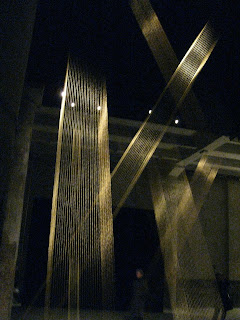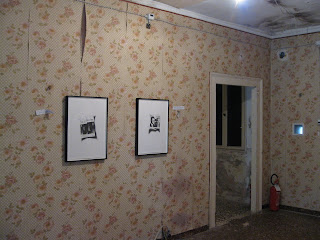 Damien Hirst's The Child's Dream (2008) uses the universal Unicorn of myths and fairy tales to challenge perceptions of beauty and the grotesque. The case can also be viewed as a coffin, especially here where it stands beside the stained glass window of the Heron Mall.
Damien Hirst's The Child's Dream (2008) uses the universal Unicorn of myths and fairy tales to challenge perceptions of beauty and the grotesque. The case can also be viewed as a coffin, especially here where it stands beside the stained glass window of the Heron Mall.  Eva Rothschild's Disappear (2004) comprises incense sticks that are burnt, probably on a weekly basis. There is mounting evidence, on the floor below the work, of the changing nature of the work.
Eva Rothschild's Disappear (2004) comprises incense sticks that are burnt, probably on a weekly basis. There is mounting evidence, on the floor below the work, of the changing nature of the work.She also has two other superb pieces in the exhibition; Stairway (2005) and Highlife (2004). Highlife is a trio of 'head' forms of black and red leather interwoven strips which turn into 'tears' that trial down to form a small pool on the floor beneath. Stairway is a series of triangular frames suspended from the ceiling and walls so that they interlock at their points. Painted black, with red inners, they are held in place (quite literally) by small black hands.
 Simon Periton Il Cornuto appears on the stairwell (left) and as a 5 colour screen print (below) the latest of the Limited Edition Prints to be sold by Tate St Ives
Simon Periton Il Cornuto appears on the stairwell (left) and as a 5 colour screen print (below) the latest of the Limited Edition Prints to be sold by Tate St Ives .
.
Combining natural forms from traditional fairy tales with images of industrial decay these pieces are at once enchanting and eerie. This is especially true of the stairwell where the work seems to be invading the building and creeping insidiously down the walls.
 Simon Periton Il Cornuto appears on the stairwell (left) and as a 5 colour screen print (below) the latest of the Limited Edition Prints to be sold by Tate St Ives
Simon Periton Il Cornuto appears on the stairwell (left) and as a 5 colour screen print (below) the latest of the Limited Edition Prints to be sold by Tate St Ives .
.Combining natural forms from traditional fairy tales with images of industrial decay these pieces are at once enchanting and eerie. This is especially true of the stairwell where the work seems to be invading the building and creeping insidiously down the walls.
Best known for his contemporary paper cuts Periton also has one of his latest works on glass in Gallery 4, hung above the doorway through which visitors enter it is easily missed, which is a shame.
Sven Berlin's Owl in Flight (1988) blurs the boundaries between nature, landscape, man and magic. Referencing the ancient standing stones of the area this haunting sculpture evokes the haunting calls and silent flight of the owl and the mythology associated with the bird.
blurs the boundaries between nature, landscape, man and magic. Referencing the ancient standing stones of the area this haunting sculpture evokes the haunting calls and silent flight of the owl and the mythology associated with the bird.
Sven Berlin's Owl in Flight (1988)
 blurs the boundaries between nature, landscape, man and magic. Referencing the ancient standing stones of the area this haunting sculpture evokes the haunting calls and silent flight of the owl and the mythology associated with the bird.
blurs the boundaries between nature, landscape, man and magic. Referencing the ancient standing stones of the area this haunting sculpture evokes the haunting calls and silent flight of the owl and the mythology associated with the bird. Peter Lanyon Construction for 'Lost Mine' (1959). Glass is an interesting medium for this piece, Mining is thought of as a though, strong, process. In reality the state if the Cornish miming industry in the 50's was very fragile, foreign competition, lack of investment and ever more difficult access to poorer quality ore seams made this an industry that could collapse at any time.
Peter Lanyon Construction for 'Lost Mine' (1959). Glass is an interesting medium for this piece, Mining is thought of as a though, strong, process. In reality the state if the Cornish miming industry in the 50's was very fragile, foreign competition, lack of investment and ever more difficult access to poorer quality ore seams made this an industry that could collapse at any time. John Latham Great Uncle Estate (1960).I had previously come across his work in the online archive and at the Flat Time House website. There is a sinister side to the work shown here, defaced and partially burnt books are never easy viewing. Latham considered books to be repositories of knowledge but this knowledge could be 'faulty' and much of his work from the 1960's questioned the truth and value of books as carriers of ideas and information.
John Latham Great Uncle Estate (1960).I had previously come across his work in the online archive and at the Flat Time House website. There is a sinister side to the work shown here, defaced and partially burnt books are never easy viewing. Latham considered books to be repositories of knowledge but this knowledge could be 'faulty' and much of his work from the 1960's questioned the truth and value of books as carriers of ideas and information. Adam Chodzko has installed a number of Secretors around the building. These glass vessels, filled with a mysterious red liquid he calls 'manifestation juice', are easily missed and this somehow adds to their air of disquiet. Placed where wall and ceiling meet they give a sense that the life-blood of the building is oozing from minute fissures in its fabric.
Adam Chodzko has installed a number of Secretors around the building. These glass vessels, filled with a mysterious red liquid he calls 'manifestation juice', are easily missed and this somehow adds to their air of disquiet. Placed where wall and ceiling meet they give a sense that the life-blood of the building is oozing from minute fissures in its fabric.  Gillian Carnegie's Black Square (2008) is a study of dark woodlands and the tales of loss and enchantment emanating from such places. The glossy black surface of the oil paint is a wonderful carrier of texture that calls out to be touched and investigated more fully. A truly moving piece that rewards time taken to study it in detail.
Gillian Carnegie's Black Square (2008) is a study of dark woodlands and the tales of loss and enchantment emanating from such places. The glossy black surface of the oil paint is a wonderful carrier of texture that calls out to be touched and investigated more fully. A truly moving piece that rewards time taken to study it in detail. Bryan Wynter's Path Through the Wood (1950) is a good contrast to Carnegie's work. This subtle monoprint draws the viewer ever further into the woods, enticement and entrapment, Hansel and Gretel spring to mind as do a number of other ancient folk tales.
Bryan Wynter's Path Through the Wood (1950) is a good contrast to Carnegie's work. This subtle monoprint draws the viewer ever further into the woods, enticement and entrapment, Hansel and Gretel spring to mind as do a number of other ancient folk tales.Paul Nash's Mansions of the Dead (1932) has a particular resonance for me with the shelving recalling archives waiting to be filled with the artifacts/memories of the departed.
has a particular resonance for me with the shelving recalling archives waiting to be filled with the artifacts/memories of the departed.
 has a particular resonance for me with the shelving recalling archives waiting to be filled with the artifacts/memories of the departed.
has a particular resonance for me with the shelving recalling archives waiting to be filled with the artifacts/memories of the departed. John Russell's vast, back-lit Untitled (2009) is a stunning example of what I would refer to as 'second-life' art. Surreal yet enchanting it overwhelms the final gallery space becoming omnipresent drawing the viewer into its central portal as if a moth drawn to a flame. Quite outstanding. The image also shows three Adam Chodzko Secretors at ceiling level in the top left hand corner of the picture. 






 John Keys
John Keys Bren Unwin
Bren Unwin





















 I have been looking at the work of
I have been looking at the work of 












